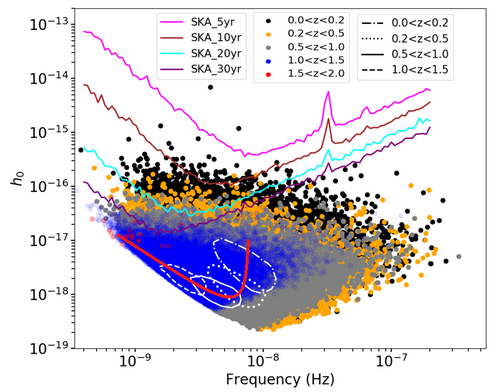Supermassive Binary Black Hole Hunter: SKA Pulsar Timing Array
Recently, researchers at National Astronomical Observatory of the Chinese Academy of Sciences (NAOC) quantified the potential of gravitational wave detection in the era of the Square Kilometre Array (SKA). This new calculation demonstrates, for the first time, that even a small number (about 20) of high-quality millisecond pulsars monitored by SKA will deliver valuable information about the redshift evolution of supermassive black hole binaries (SMBBH). The paper is published in Physical Review D.
Supermassive black holes are commonly found in the center of galaxies and evolve with their hosts. SMBBHs are thus expected to exist in close galaxy pairs. However, none has been unequivocally detected. The research team, led by Mr. Yi Feng and his supervisor Dr. Di Li, together with Drs. Chaowei Tsai and Zheng Zheng, carried out semi-analytical numerical simulation to estimate the number of detectable SMBBHs with SKA Pulsar Timing Array (SKA-PTA).
Based on infrared galaxy samples and statistical assumptions of the SMBBH population, the team calculated their low-frequency gravitational wave characteristics at different redshifts.
SKA is a multi-purpose radio telescope with a collecting area approaching 1 million square metres, thus holds great potential for detecting nanohertz gravitational waves. Different from the hundreds of pulsars commonly assumed to be necessary in previous work, the new calculation demonstrates that a SKA-PTA consisting of merely ~20 pulsars is capable of achieving gravitational wave detection within 5 years of operation and growing to a detection rate of more than 100 SMBBHs/yr after about 10 years. Within 30 years of operation, about 60 individual SMBBHs detection with z < 0.05 and more than 104 within z < 1 are expected (Figure 1).
The substantial number of expected detections and their evolution with redshift discernable by SKA-PTA will make SKA a significant tool for studying evolution of SMBBHs and their host galaxies.

Figure 1: The red curve cross the contour centers shows the evolution trend of SMBBH population from low redshift to high redshift: the gravitational wave frequencies increase; the gravitational wave strains decrease first and then increase.
The paper is available at https://link.aps.org/doi/10.1103/PhysRevD.102.023014